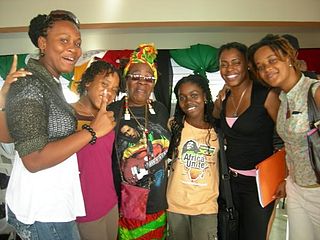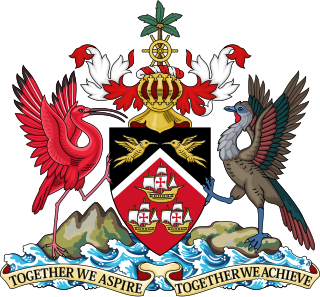
Trinidad and Tobago competed at the 2011 World Aquatics Championships in Shanghai, China between July 16 and 31, 2011.

Trinidad and Tobago competed at the 2011 World Aquatics Championships in Shanghai, China between July 16 and 31, 2011.
Trinidad and Tobago qualified 3 swimmers. [1]
| Athlete | Event | Heats | Semifinals | Final | |||
|---|---|---|---|---|---|---|---|
| Time | Rank | Time | Rank | Time | Rank | ||
| George Bovell | Men's 50m Freestyle | 22.03 | 3 Q | 22.02 | 6 Q | 22.04 | 7 |
| Joshua McLeod | Men's 50m Butterfly | 24.41 | 29 | did not advance | |||
| Men's 100m Butterfly | 55.80 | 45 | did not advance | ||||
| Athlete | Event | Heats | Semifinals | Final | |||
|---|---|---|---|---|---|---|---|
| Time | Rank | Time | Rank | Time | Rank | ||
| Cherelle Thompson | Women's 50m Freestyle | 27.21 | 42 | did not advance | |||
The history of Trinidad and Tobago begins with the settlements of the islands by Indigenous First Peoples. Trinidad was visited by Christopher Columbus on his third voyage in 1498,, and claimed in the name of Spain. Trinidad was administered by Spanish hands until 1797, but it was largely settled by French colonists. Tobago changed hands between the British, French, Dutch, and Courlanders, but eventually ended up in British hands following the second Treaty of Paris (1814). In 1889, the two islands were incorporated into a single political entity. Trinidad and Tobago obtained its independence from the British Empire in 1962 and became a republic in 1976.

This article is about the demography of the population of Trinidad and Tobago including population density, ethnicity, education level, health of the populace, economic status, religious affiliations and other aspects of the population.

The economy of Trinidad and Tobago is the third wealthiest in the Caribbean and the fifth-richest by GDP (PPP) per capita in the Americas. Trinidad and Tobago is recognised as a high-income economy by the World Bank. Unlike most of the English-speaking Caribbean, the country's economy is primarily industrial, with an emphasis on petroleum and petrochemicals. The country's wealth is attributed to its large reserves and exploitation of oil and natural gas.

Port of Spain, officially the City of Port of Spain, is the capital of Trinidad and Tobago and the third largest municipality, after Chaguanas and San Fernando. The city has a municipal population of 49,867 (2017), an urban population of 81,142 and a transient daily population of 250,000. It is located on the Gulf of Paria, on the northwest coast of the island of Trinidad and is part of a larger conurbation stretching from Chaguaramas in the west to Arima in the east with an estimated population of 600,000.

Tobago is an island and ward within the Republic of Trinidad and Tobago. It is located 35 kilometres northeast of the larger island of Trinidad and about 160 kilometres off the northeastern coast of Venezuela. It lies to the southeast of Grenada and southwest of Barbados.

Trinidad is the larger and more populous of the two major islands of Trinidad and Tobago. The island lies 11 km (6.8 mi) off the northeastern coast of Venezuela and sits on the continental shelf of South America. It is the southernmost island in the West Indies. With an area of 4,768 km2 (1,841 sq mi), it is also the fifth largest in the West Indies.

The Trinidad and Tobago national football team, nicknamed the "Soca Warriors", represents the twin-island Republic of Trinidad and Tobago in international football. It is controlled by the Trinidad and Tobago Football Association, which is a member of CONCACAF, the Caribbean Football Union (CFU), and the global jurisdiction of FIFA.

Trinidad and Tobago is divided into seven regions, five boroughs, two city corporations and one ward.
Religion in Trinidad and Tobago, which is a multi-religious country, is classifiable as follows:

The Trinidad and Tobago Football Association (TTFA) is the governing body of football in Trinidad and Tobago. It is based in Port of Spain, Trinidad. It is a member of FIFA and is responsible for governing amateur and professional football and including the men's and women's national teams. The TTFA is also responsible for sanctioning referees and football tournaments for leagues in Trinidad and Tobago.

The Trinidad and Tobago national rugby union team has thus far not qualified for the Rugby World Cup, but has participated in qualifying tournaments since 1999. They are classed as a tier-three nation by World Rugby.
Rugby union in Trinidad and Tobago is a popular sport. There are currently 4,457 registered players, and 13 clubs. They are currently ranked 45th in the world.
The 1971 CONCACAF Championship, the fifth edition of the CONCACAF Championship, was held in Trinidad and Tobago from 20 November to 5 December.

Diplomatic relations between the Soviet Union and Trinidad and Tobago were established on June 6, 1974. Russia is represented in Trinidad and Tobago through a non-resident embassy in Georgetown, Guyana.

Trinidad and Tobago competed at the 2012 Summer Olympics in London, United Kingdom from 27 July to 12 August 2012. This was Trinidad and Tobago's most successful Summer Olympics. It was the nation's largest ever delegation sent to the Olympics, with a total of 30 athletes, 21 men and 9 women, in 6 sports. Trinidad and Tobago's participation in these games marked its sixteenth Olympic appearance as an independent nation, although it had previously competed in four other games as a British colony, and as part of the West Indies Federation. The nation was awarded four Olympic medals based on the efforts by the athletes who competed in the track and field. Javelin thrower Keshorn Walcott became the first Trinidadian athlete to win an Olympic gold medal since the 1976 Summer Olympics in Montreal, where Hasely Crawford won for the sprint event. Marc Burns, a four-time Olympic athlete and a relay sprinter who led his team by winning the silver medal in Beijing, was the nation's flag bearer at the opening ceremony.

The bilateral relations between the Republic of India and the Republic of Trinidad and Tobago have considerably expanded in recent years with both nations building strategic and commercial ties. Both nations formally established diplomatic relations in 1962. Indo-Trinidadian and Tobagonians form the largest ethnic group in the country at 37.6% of the total population.

Women in Trinidad and Tobago are women who were born in, who live in, or are from Trinidad and Tobago. Depending from which island the women came, they may also be called Trinidadian women or Tobagonian women respectively. Women in Trinidad and Tobago excel in various industries and occupations, including micro-enterprise owners, "lawyers, judges, politicians, civil servants, journalists, and calypsonians." Women still dominate the fields of "domestic service, sales, and some light manufacturing."

Visitors to Trinidad and Tobago must obtain a visa unless they are citizens of one of the visa-exempt countries.

Trinidadians and Tobagonians, colloquially known as Trinis or Trinbagonians, are the people who are identified with the country of Trinidad and Tobago. The country is home to people of many different national, ethnic and religious origins. As a result, Trinidadians do not equate their nationality with race and ethnicity, but with citizenship, identification with the islands as whole, or either Trinidad or Tobago specifically. Although citizens make up the majority of Trinidadians, there is a substantial number of Trinidadian expatriates, dual citizens and descendants living worldwide, chiefly elsewhere in the Anglosphere.